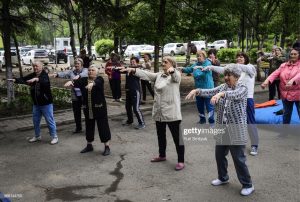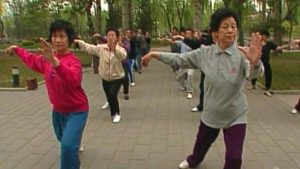Improve Physical and Mental Health in Trauma Victims with Bikram Yoga
By John M. de Castro, Ph.D.
“The steamy temps “allow you to increase their range of motion and stretch deeper within each pose,” since heat makes muscles more pliable, says Numbers. Unlike stretching it out in a standard cool yoga studio, the heat will have you feeling like a pro and extending further than you thought you could.” – Aryelle Siclait
Experiencing trauma is quite common. It has been estimated that 60% of men and 50% of women will experience a significant traumatic event during their lifetime. Trauma can produce troubling physical and psychological symptoms that need to be addressed. There are a number of therapies that have been developed to treat the effects of trauma. One of which, mindfulness training has been found to be particularly effective. Yoga practice is a mindfulness practice that has been shown to be helpful for trauma survivors.
Yoga is a mindfulness practice that has been shown to improve physical well-being and cardiovascular health. Bikram Yoga is somewhat unique yoga practice as it employs a set sequence of 26 poses (asanas) and two breathing exercises. It is practiced in a heated environment (105°F, 40.6°C, 40% humidity) and there is a unique programmed instructional dialogue. The hot environment is thought to soften the muscles making them more pliable and loosen the joints making them more flexible allowing the practitioner to go deeper into poses. The sweating that occurs is thought to help remove toxins and impurities.
In today’s Research News article “#MindinBody – feasibility of vigorous exercise (Bikram yoga versus high intensity interval training) to improve persistent pain in women with a history of trauma: a pilot randomized control trial.” (See summary below or view the full text of the study at: https://www.ncbi.nlm.nih.gov/pmc/articles/PMC6714085/), Flehr and colleagues recruited adult pre-menopausal women who had persistent pain and who had experienced trauma. They were randomly assigned to receive 8 weeks of 3 sessions per week of Bikram Yoga (90 minutes) or High Intensity Interval Training (45 minutes). The women were measured before and after training for pain severity, pain interference with quality of life, health, anxiety, depression, perceived stress, disorders of extreme stress, self-efficacy, life stressors, mindfulness, body size, and electrocardiogram (EKG) measures.
They found that pain significantly decreased for both groups. On the other hand, Bikram Yoga produced significantly greater improvements in physical functioning, mental health, and heart rate variability with moderate to large effect sizes. No intervention related injuries were reported. Heart rate variability has been shown to measure greater parasympathetic nervous system activity reflecting better overall health.
The results suggest that although both programs produced decreased pain intensity, Bikram Yoga was superior to a comparable high intensity exercise in improving the physical and mental health of trauma survivors with persistent pain. A strength of the study is that the Bikram Yoga intervention was compared to another high intensity exercise program, thus reducing the likelihood of participant expectancy effects. Hence Bikram Yoga appears to be a safe and effective treatment for women who have experienced trauma. It would be interesting in the future to compare the Bikram Yoga program to a comparable yoga program practiced at room temperature.
So, improve physical and mental health in trauma victims with Bikram Yoga.
“Hot yoga addresses all aspects of physical fitness including muscular strength, endurance, flexibility and weight loss. . . . There is no other style of yoga that addresses the overall health of the body in such a comprehensive way.” – Peter Mason
CMCS – Center for Mindfulness and Contemplative Studies
This and other Contemplative Studies posts are also available on Google+ https://plus.google.com/106784388191201299496/posts and on Twitter @MindfulResearch
Study Summary
Flehr, A., Barton, C., Coles, J., Gibson, S. J., Lambert, G. W., Lambert, E. A., … Dixon, J. B. (2019). #MindinBody – feasibility of vigorous exercise (Bikram yoga versus high intensity interval training) to improve persistent pain in women with a history of trauma: a pilot randomized control trial. BMC complementary and alternative medicine, 19(1), 234. doi:10.1186/s12906-019-2642-1
Abstract
Background
The neurobiology of persistent pain shares common underlying psychobiology with that of traumatic stress. Modern treatments for traumatic stress often involve bottom-up sensorimotor retraining/exposure therapies, where breath, movement, balance and mindfulness, are used to target underlying psychobiology. Vigorous exercise, in particular Bikram yoga, combines many of these sensorimotor/exposure therapeutic features. However, there is very little research investigating the feasibility and efficacy of such treatments for targeting the underlying psychobiology of persistent pain.
Methods
This study was a randomized controlled trail (RCT) comparing the efficacy of Bikram yoga versus high intensity interval training (HIIT), for improving persistent pain in women aged 20 to 50 years. The participants were 1:1 randomized to attend their assigned intervention, 3 times per week, for 8 weeks. The primary outcome measure was the Brief Pain Inventory (BPI) and further pain related biopsychosocial secondary outcomes, including SF-36 Medical Outcomes and heart rate variability (HRV), were also explored. Data was collected pre (t0) and post (t1) intervention via an online questionnaire and physiological testing.
Results
A total of 34 women were recruited from the community. Analyses using ANCOVA demonstrated no significant difference in BPI (severity plus interference) scores between the Bikram yoga (n = 17) and the HIIT (n = 15). Women in the Bikram yoga group demonstrated significantly improved SF-36 subscale physical functioning: [ANCOVA: F(1, 29) = 6.17, p = .019, partial eta-squared effect size (ηp2) = .175 and mental health: F(1, 29) = 9.09, p = .005, ηp2 = .239; and increased heart rate variability (SDNN): F(1, 29) = 5.12, p = .013, ηp2 = .150, scores compared to the HIIT group. Across both groups, pain was shown to decrease, no injuries were experienced and retention rates were 94% for Bikram yoga and 75% for HIIT .
Conclusions
Bikram yoga does not appear a superior exercise compared to HIIT for persistent pain. However, imporvements in quality of life measures and indicator of better health were seen in the Bikram yoga group. The outcomes of the present study suggest vigorous exercise interventions in persistent pain cohorts are feasible.
https://www.ncbi.nlm.nih.gov/pmc/articles/PMC6714085/









